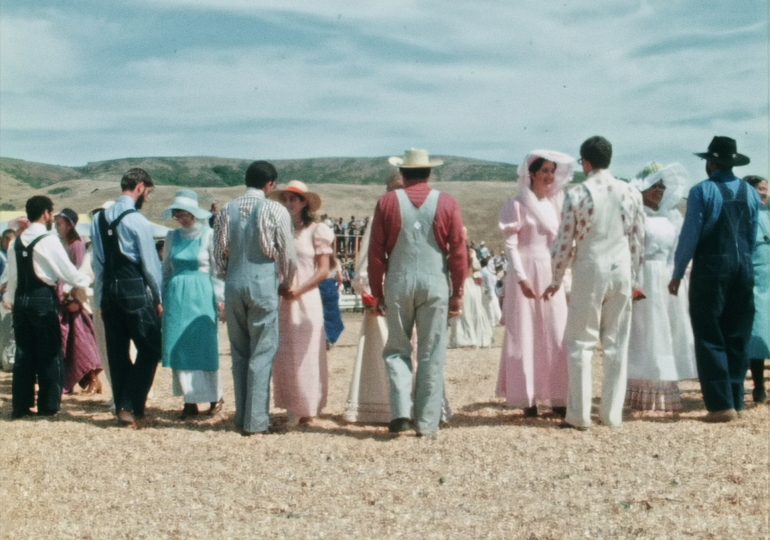What happens when a rehab program that is supposed to cure addictions becomes addictive itself?
That’s the story of Synanon, an organization that went from providing revolutionary therapy to becoming “a kooky cult,” as TIME put it in 1977. The HBO docu-series The Synanon Fix, out April 1 and streaming on Max, traces the rise and fall of the organization in the 1960s and 1970s through interviews former members, as well as some of the children who lived in its housing. The filmmakers also obtained footage from residents who were amateur filmmakers and photographers from their time with Synanon.
[time-brightcove not-tgx=”true”]
Charles Dederich, a former alcoholic who had gotten sober through Alcoholics Anonymous, started Synanon in 1958, during a heroin epidemic in the U.S. Dederich had felt that people didn’t open up enough in AA and aimed to take it further with Synanon. The cornerstone of Synanon’s approach was a kind of confrontational group therapy called “the Synanon game,” in which participants would scream what they really thought of one another—and then hug it out afterwards. Donald Cressey, University of California at Los Angeles sociologist, described Synanon to TIME in 1961 as “the most significant attempt to keep addicts off drugs that has ever been made.”
Even after people got sober, they stuck around. Some had burned too many bridges back home, and stories of people relapsing also made some afraid to leave. By the 1960s, Synanon had become not only a treatment facility, but a communal living experiment, taking over a three-story building in Santa Monica. Mass weddings were performed. Members were encouraged to start families and took turns watching over each other’s kids. Most of the residents hung out in communal spaces, but could reserve a private room with candles for sex by putting their names down on a sign-up sheet. Many shaved their heads.
Over four episodes, The Synanon Fix explores what happened at the organization and how it affected the residents. The former members who share their experiences in the docu-series all emphasize how lonely they were when they joined the organization, something director Rory Kennedy (Bobby Kennedy’s daughter) hopes audiences will see as a kind of warning.
“When there’s a feeling of living through unsettled times, there’s an attraction to alternative lifestyles,” Kennedy says. “Given where we are with social media and AI and the threats of climate change, many people are anxious, and they want to tether themselves to something that is grounding.”
How Synanon attracted members
During the counterculture of the 1960s and 1970s, Synanon began to attract people who were lonely and desperate for a community at a time when trust in government plummeted after the Vietnam War and the Watergate scandal. The organization welcomed people of all races in the early 1960s, which was progressive for the time period.
“I really saw the organization as a vital approach to civil rights,” Rod Mullen, who was a member of Synanon for more than a decade, says in The Synanon Fix. Elena Broslovsky, who spent two decades with the group, says that she joined because she was in “despair about our country” after the 1963 assassination of President John F. Kennedy and the 1968 assassinations of his brother Attorney General Bobby Kennedy and civil rights leader Martin Luther King, Jr. Synanon’s alternative living model also fit right in with the “free love” counterculture movement and communal living experiments that cropped up during this period.
Terry Hurst, whose husband was a board member at Synanon, described electric dance parties without any smoking or alcohol or drugs. Top musicians who sought out Synanon for help included Art Pepper and Joe Pass. “We had our own Synanon dance called the hoopla,” Hurst explains in the docu-series. To dance “the hoopla,” residents would wave their arms and legs wildly, in any directions they wanted to, to represent how they could be totally uninhibited in the program.
The kids of residents described looking out after themselves because their parents were preoccupied with the Synanon game. In the docu-series, Bill Goodson, who started living in Synanon with his mother at age 3, said he bonded immediately with the other residents’ kids, and they played together on the beach all day. But it wasn’t all fun and games. They were also put to work, emptying puke buckets, and getting cold rags for the addicts lying on couches in communal areas. “Synanon was an experiment,” he argues in the series, “and the thought of children was the last thing on [Dederich’s] mind.”
The decline of Synanon
But as Synanon’s eccentric leader Dederich started to decline, so did the organization. He began drinking again after his wife died in 1977 and remarried soon after. Then, he decided everyone in Synanon would also benefit from remarrying, and called for wife-swapping. Suddenly, men and women who were married to one another at Synanon were divorcing and marrying different people affiliated with the organization.
After encouraging people to raise families at Synanon, he called for residents to be childless. Men started to get vasectomies, like Mike Gimbel, who credits Synanon for getting him clean and worked for the organization in the 1970s. He says in the series that he was in love with his wife, but they decided to separate when Dederich called for wife-swapping. When she got pregnant, she got an abortion because they were afraid of running afoul of Dederich. As he puts it in the final episode, “Synanon saved my life, but screwed it up too.”
Negative press and lawsuits also fueled the demise of the group. In October 1978, Paul Morantz, a lawyer who won class-action suits for ex-Synanon members, was pulling his mail from the mailbox when a rattlesnake bit him. He survived, and two Synanon members—who called themselves part of the “Imperial Marines”—were arrested and convicted for trying to kill him. Dederich was sentenced to five years probation in the case. Synanon even went after TIME magazine, suing Time Inc for more than $76 million over the Dec. 26, 1977, article that called it “a kooky cult.” Synanon organized demonstrations by TIME’s headquarters in midtown Manhattan, parading around with signs and urging passersby to boycott the publication. The suit was dropped, but Synanon could not regain public favor, closing down after the IRS revoked the group’s tax-exempt status in 1982.
Leave a comment








